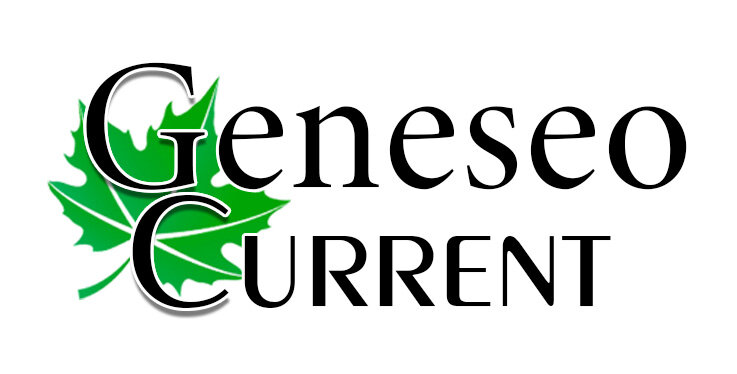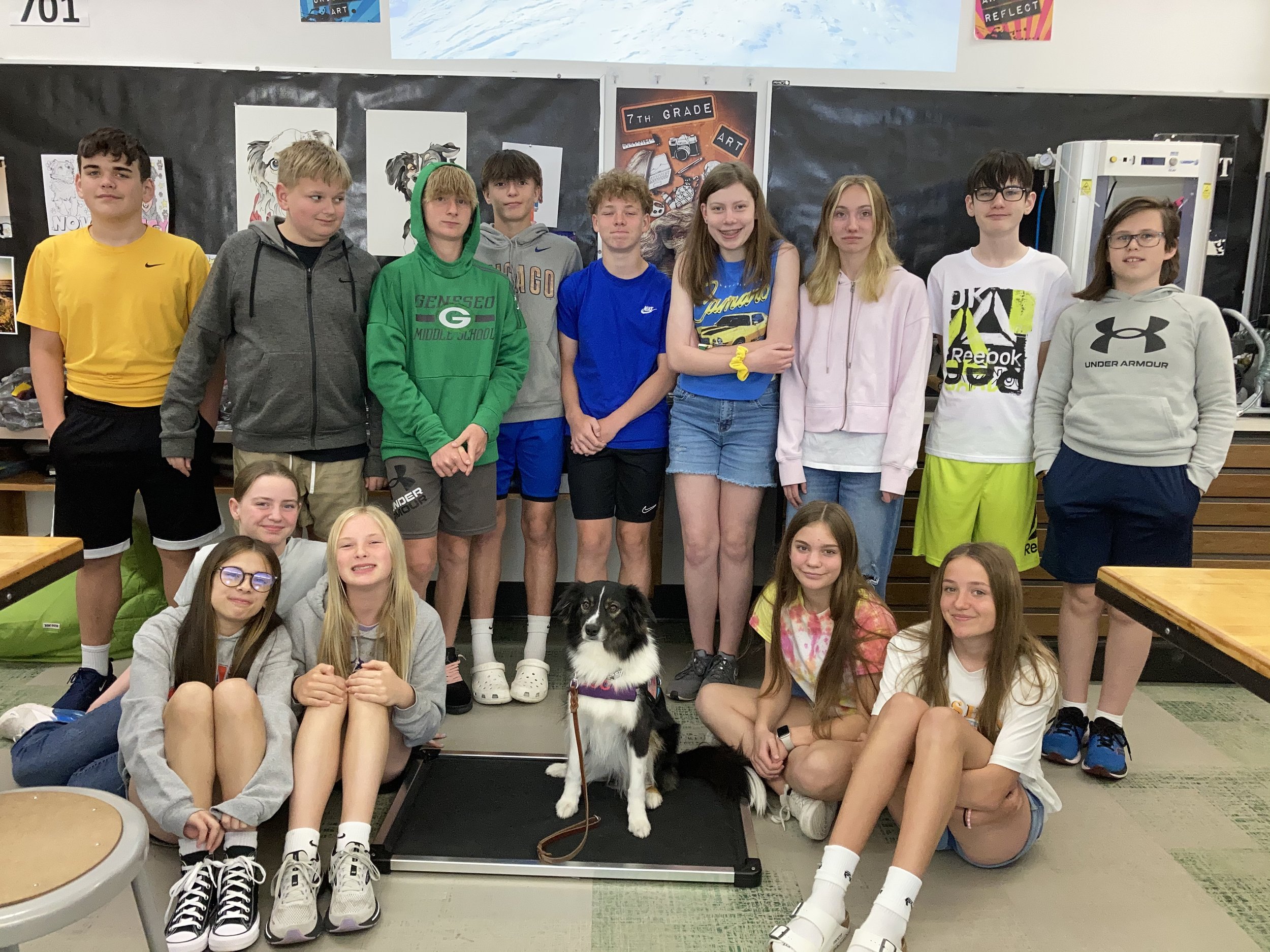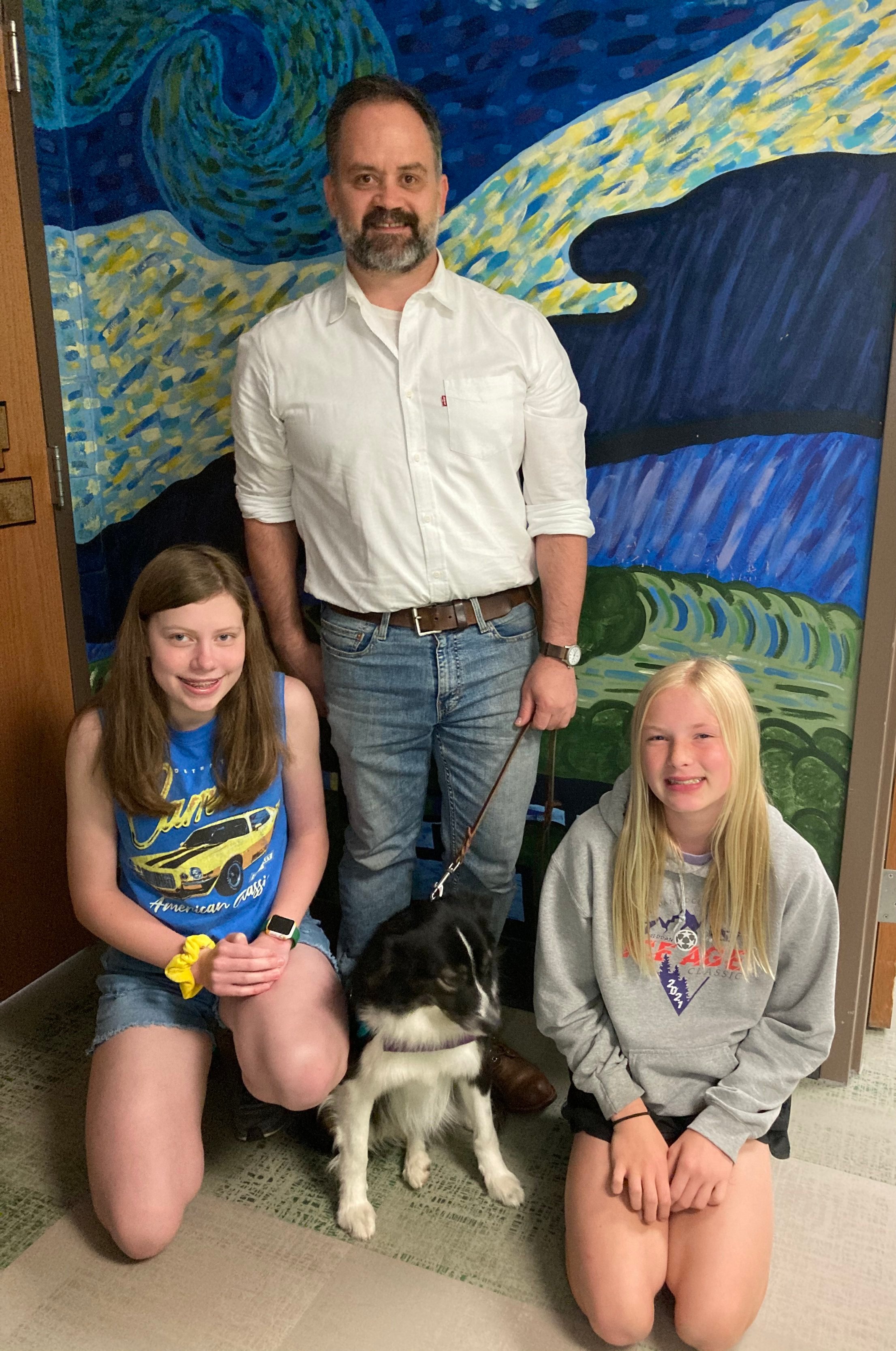By Claudia Loucks
Geneseo Current
Meet Lucy, the therapy dog who accompanies Geneseo Middle School art instructor Logan Hamilton to classes every school day.
Hamilton shared how Lucy came to be part of his teaching routine and he said, “I frequently need to adjust my curriculum to meet my students evolving emotional needs, which requires the constant designing and scrapping of ineffective methods.”
It was that frustration that led him to create a more unconventional social-emotional learning instruction method that incorporates his other passion: his therapy dog Lucy.
“I began developing this idea,” he explained. I wondered how I could use a therapeutic approach, beyond sensory experiences and reading support, to enhance social-emotional learning (SEL) every day.”
“The first day Lucy was in my room, I quickly discovered that everyone talks dog,” he said. “Whether they own a dog or have a friend who owns a dog, everyone seems to have some sort of connection, which makes this the perfect icebreaker to get the SEL conversation rolling. Even students who aren’t fond of dogs can participate in the class discussion by sharing their reasons.”
Hamilton said the connection was an inspiration for him,”forcing me to analyze more purposely the ways our discipline is inherently SEL-based. In fact, it is near impossible to avoid SEL when teaching art. I focused on tapping into this relationship by designing SEL lessons that followed a framework using Lucy as the lesson starter, sandwiching the core SEL content in the middle, and finishing with art-making SEL connections.”
Lucy is part of Hamilton’s daily instruction by way of meditations and brain breaks and he said some days are set aside for specific social-emotional learning lessons…”My most successful lesson to date is focused on relationship skills connected to tone of voice.”
He begins by defining tone of voice and then asks his students if they have unintentionally found themselves in a situation where a friend or adult told them, “I don’t like your tone.”
“Almost everyone has a grievance to share which sets the stage for this lesson,” added. “I transition to dog training connections with Lucy as a model. We discuss how tone of voice impacts how Lucy interprets her commands. As we transition to the middle of the lesson, I focus on the way tone relates to peer and adult conversations. We begin by watching a short video that shows modeled interactions with misperceived tones, including explanations.”
Hamilton said the best way for students to get the hang of tone and to discuss its implications is by role-playing…”Each student is challenged with reading sample statements such as ‘What happened to you?’ in a neutral tone. As a class we discuss how the tone changes the meaning of the statement.”
As they finish the lesson, Hamilton said they discuss how tone and mood is portrayed in art.
He said while the importance of tone represents only one of many ways Lucy is integrated into his art lessons, he has begun to experience the positive impacts…”By the end of the year, students began to self-correct when communicating with their classmates and parents.”
From listening to comments from his students, Hamilton said, “These comments give me validation that this therapy dog-centered approach to SEL and art is creating a more supportive classroom environment while connecting students it the art-making process and their peers.”
When Hamilton was asked how Lucy came into his life, he explained that after Covid, the Geneseo School District scheduled a Professional Development Day and a local therapy dog group, QCCAN (Quad Cities Canine Assistance Network) took a team of dogs to the high school as one of the distress sessions.
“I was really inspired by the work the handlers did and I had no idea that therapy not-for-profit existed,” he said.
That led him to begin researching what it takes to train a therapy dog…’I looked into all the local therapy dog organizations, and I investigated what dog breeds were best for the work,” he said. “I spent the better half of a year locating a breeder and going through the selection process of choosing a dog that had the right temperament for the work.”
He chose Lucy, a mini-American Shepherd.
Geneseo Middle School seventh grade students photographed with Lucy are, in front from left, Lilly Marshall, Faith Schaver, Emma Minnaert, Katrina Nerud, Peyton Brodie; in back, Kellan Miller, Boston Brewer, Hunter Brooks, Maysen York, Jeff Znamenacek, Molly Wannemacher, Tori Finegan, Landen Burk and Ean Tank. Photo by Claudia Loucks
During his research, Hamilton said he also found himself wondering what other ways therapy dogs could be integrated into a classroom setting beyond sensory experiences.
He reached out to several resources he found online that included a middle school art teacher in Geneseo, NY; a museum director in Canada, and a magazine editor, all of which had experience implementing dogs into instruction.
It was then that Hamilton began to design his own unique ways of using the dog as an instructional tool as well as a means to relieve stress for his students.
He attends monthly classes with the Quad Cities Canine Assistance Network…”This is a local not-for-profit that volunteers across the QC area,” he said. “I also am a mentor for the group and I work with a committee of other trainers who also have facility dogs in the surrounding schools. Together, we help design training instruction for other area handlers who want to use their therapy dogs in their classroom or office.”
Molly Wannemacher, left; Logan Hamilton, Geneseo Middle School art teacher; and Emma Minnaert pose for a photo with Lucy, the therapy dog who assists Hamilton in his art classes.


